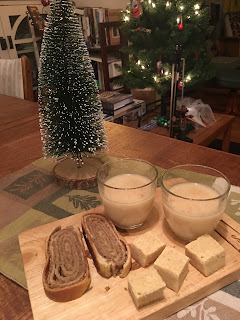Tangled roots and family secrets. A famous immigrant writer who died under mysterious circumstances. Accordions, polkas and potica. And now a new twist: My Year of Cooking Ethnically.
Family History
Saturday, December 25, 2021
Sunday, December 5, 2021
No-Knead Slovenian Rye Bread, Artisan style
This feels like a good time to share this overdue rye bread recipe. Thanks to my procrastination, it now coincides with an important cooking anniversary. Two years ago at this time, I discovered a popular artisan bread-making method that quickly became a pandemic mainstay and eventually crept into my Slovenian baking, including this recipe.
It was December 2019, during our last pre-pandemic holiday season. I wandered into a Christmas market sponsored by a local senior center and left with an intriguing cookbook called "Artisan Pizza and Flatbread in Five Minutes a Day." This was my introduction to the popular "Artisan Bread in 5" approach developed by Jeff Hertzberg and Zoë François in their ever-expanding collection of cookbooks and websites. Their master recipe for bread is a good place to start for anyone unfamiliar with their approach, which is based on bulk cold fermentation of a very soft dough that does not require kneading.
The recipe below is something of a hybrid. The foundation is a recipe from the 1950s cookbook published by the Progressive Slovene Women of America, who called it Quick Rye Bread--or rženi kruh na hitro, which translates as "rye bread in a hurry."
That vintage recipe felt surprisingly contemporary. For one thing, it called for a mix of rye, whole wheat and white flour, with the whole grains predominating. And the proportions in the recipe, including the flour/liquid balance, seemed identical to the new artisan breads I had been making. The only real difference (aside from the use of cake yeast in the older recipe) is that the artisan method recommends refrigerating the dough for at least two hours, and sometimes as long as two weeks, before baking. Along with the convenience of always having a supply of yeast dough on hand, the extended cold storage encourages the development of a more complex, fermented dough that comes to resemble sourdough.
So I decided to apply the artisan method to that older Slovenian American recipe. I refrigerated the dough for the minimum time suggested by the artisan people, because I wanted to have the bread ready by dinnertime. In theory, the dough could have been refrigerated for up to five days. Without whole grains, refrigerated dough can be safely stored for as long as two weeks, according to Hertzberg and François, so long as it is free of eggs or dairy products.
The bread was a success. It was flavorful and a little spongy, with none of the dense heaviness that whole grain breads sometimes have. It also made excellent toast. The next time, I might save half the dough for later to see how the flavor changes with longer storage. A sprinkle of caraway seeds would also add a nice touch.
Combine yeast, salt and sugar in a large bowl or container. Heat milk and butter and cool to lukewarm. Add to the large container and stir well. Combine the flours, add to the liquid ingredients, and stir until blended into a loose dough. Cover loosely and let rise for 2 hours at room temperature. Although the dough can be used at this point, it is easier to handle (and more flavorful) if it is refrigerated for at least 2 hours. When ready to bake, divide the dough into two small oiled loaf pans. (Or, if you prefer, save half the dough for up to five days and bake later.) Let the dough rise until doubled and bake at 375 degrees for 45 minutes to an hour. Remove from pan(s) and let cool before slicing.



